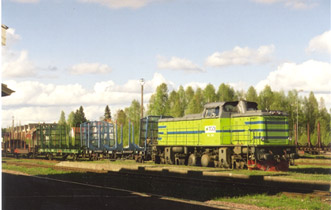
A TGOJ T43 resting for the weekend in Orsa, August 2001. See more in Ollies trainstuff!, all colorphotos by Ollie Ahokas
Nohabs!
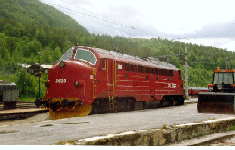
A classic engine on a classic scene. A Di3.a in Dombås in the late nineties.
Photo and scan by Ollie Ahokas
Nohab started their production of railroad power in the 1880.es with the small narrow gauge tank engine which was named Trollhettan, and within time became to the major producer of power for the the power hungry railroads in the country. In 1910.es started experiments with combusted engine for power for trains by the firm DEVA. Mostly they were heavyweight motorcars, with bulky engines that delivered limited power, they were unreliable and could not threathen steam. the Swedish National network electrified their lines in the 1920-es and therefore showed a limited interest for early diesel engines. Mostly, small critters were built for light switching. During the thirties small railcars started to replace steam on remote lines, where steamtrains to started to loose ground to trucks, buses and increasing numbers of cars. But after nationalizing of the various privately owned lines a need of more standardized power was needed.
Starting out with new classes with steam, soon the improvements of dieselpower abroad, lead to the first larger diesel power in the country, based on various German designs. The first, though was English Electrics 3 units stronge V-class followed by V3-class based on modified Deutsche Wehrmacht roddriven 0-6-0.s. The next large class was the T2, class (later T21/22-class)These was 800-hp standard MaK-designs and were also suitable for mainline duties. These engines lasted in service to 1980-es.
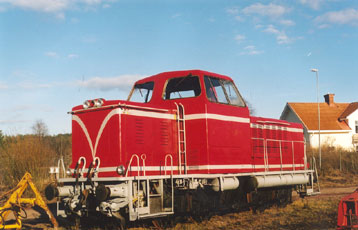
One of the last survivers of the MaK designs T21 58 seems to be abbandoned close the roundhouse in Orsa, suffered by cracked camshaft. The previous owner had the engine decked out in this rather handsome fashion.
Photo and scan by Ollie Ahokas
TMX on IBAB
There are four units on IBAB #.s 1013 - 1016. The 1016 is primaly used on passenger and special trains while the 1013 - 1015 are used on freghts on daily bases along with leased units, Mostly of TMY from Tågab and T43.s from TGOJ and Banverket.#1016 differs from the sister units also by having somewhat different shade of the red color and different markings.
1013

1014




1015


1016




Leased Power
TGOJ T43

TÅGAB TMY 106




More Nohabs!
Here are a selection of various Nohabs in Sweden and Norway. If you are a little curious on prototype images from Scandinavia help yourselves to theOllies Trainstuff! section.
IBAB 1014 & 1015




TÅGAB TMY 103


Norway.
NSB Di3.a 3606


NSB Di3.a 3617



NSB Di3.a 3623

NSB Di3.a 3628


NSB Di3.a 3629



For more photos and comments,
Ollies Trainstuff!
Engines powered by EMD 567-engines
In 1954 EMD sent over a G12 engine to promote their product in post-war Europe. The engine arrived by ship in Gothenburg, and was demonstrated in Scandinavia and by German Henschler in Germany. Eventually the engine was sold to SJ and numbered as T42 205, and for years ran in Haaparanta area as the engine compared other diesels very noisy. The engine was retired in 1980.es and sold to GM-gruppe and is repainted in the original scheme used in the demonstration tours as used on excursions in Norway.Steam proved during this time more and more uneconomical and national railways in neighbouring Denmark and Norway, decided to replace steam with diesel power. Based on EMD.s F7.s a prototyped numbered as NoHab 2246 rolled out, there was number of changes, the Blomberg B-trucks were replaced by three axle trucks in A-1-A configuration, a single cabbed units were considered as not suitable in European shorter runs, a second cab was added. The engine was sent to successful demonstration over Europe and during this time the first five of series was produced. 4 was delivered to Danish National Railway as MY1101-1104 and the fifth was sent to Norway for demonstration, NSB liked the engine enough to order their first 5 engines during the demonstration. The NSB.s engines differ by they are only engines of this type as they are powered by all six-axles, and to protect fans on the roof a hump was constructed on these units. NoHab built on speculation five more engines to be sold to Finland but unknown reasons the deal didn't come through and of the regauged engines all were sold to Norway. 3 of them was pretty much completed and retained their A-1-A trucks and reclassified as Di3bs, while the remaining pair were delivered with C-trucks. These engines vary also by being 30 cm longer than other Di3.s delivered to NSB. All the C-trucked engines were reclassified as Di3a.s. In all NSB received 35 Nohabs between 1955 and 1969. During the years they were modified in number of ways, mostly appearing was changes in paint schemes, number of doors to the cabs were reduced, pilots were in most units replaced by plods, in most was the cab windows changed to bullet-proofed class, received various changes in headlights and a number of doors. All were retired in year 2000.
The other country dominated by Nohab cab units was Denmark, where three different versions of Nohabs were running. Besides of the MY, a wholly Danish version was constructed called MV. But testing of the MY contra MV, proved MY as a winner and in all 59 engines were sold to Denmark. And lightweight version called MX, with a 12-cylinder power plant was custom designed to meet the requirement of maximum 15 tons loading per axle (MY, 17 tons). Like in Norway, they handled all types of trains, from passenger express to heavy freight. A number of the MX.s and MY.s were in late 1990.s sold to private lines in Denmark and Sweden is run daily on a number of operators. In Sweden they are reclassified as TMX and TMY.
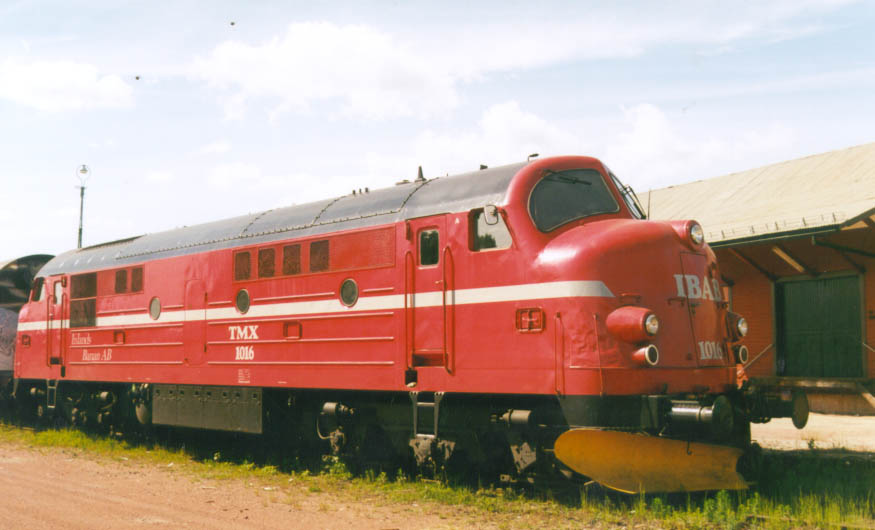
IBAB purchased 4 MX.es from Denmark. repainted in their own scheme and used on the freights.
Photo and scan by Ollie Ahokas
Scandinavia is not the area where you could find NoHab cab units, In Belgium, on NoHabs licence; Anglo Franco Belle built in all 30 engines during 1955-1957 for SNCB and 4 for Luxembourg. Some of the Belgians received a rebuilding which resulted that the handsome lines of the original was lost, they are all retired. For Hungary, 20 engines were delivered, but they are all retired.
Today it is ironic that this Swedish built classic that was turned down by the Swedish lines during the fifties, still as second-hand polishes rails in Sweden, after they were retired in the original countries.
The centercabed Nohabs with 567-engines
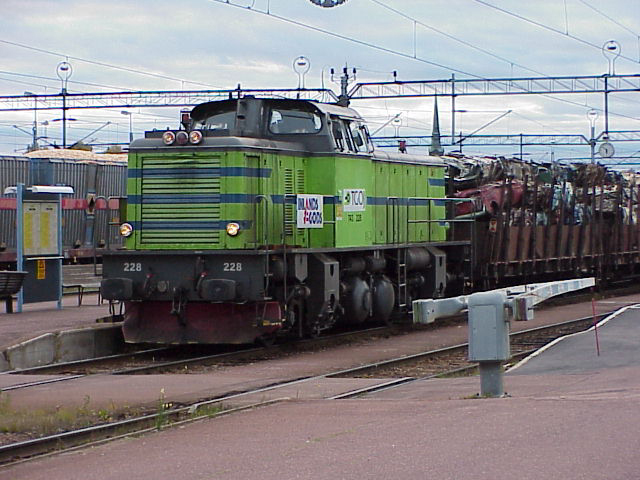
TGOJ (former SJ unit) t43 228 with eight loads of scrapped atomobiles waits for departure in September 2002 in Mora.
Sweden, one of the grand scale electric railroad pioneers, were not interested in heavy mainline units. The mainlines were electrified, and the remaining was considered mostly as uneconomical branch lines awaiting abandonment. But reaction in the communities along these lines, though not using it serviced saw and still sees them as a lifelines and SJ needed engines to be used as road switchers. During the early production of cab versions SJ ordered 4 hood unit version with an off center central cabs. They were called as T5 class but later reclassified as T41 class and numbered from 100-105 to 200-205 class. They resemble a lot of EMD.s NW5.s, but the cab looking more like a vegetable greenhouse. The last of these units no 204 was retired in 1980-es and preserved by the National Railway Museum in Gävle, but is stored by preserved group mfGDJ in Falun. The next engines of the T43-class was built in numbers, 50 of them numbered 209-258 between 1961-1963. They differ from all engines in all respects except for their prime movers. They ride on Swedish designed B-B trucks, like the Danish MX the prime mover is a 12-cylinder version and they are much shorter compared to the other previous mentioned Nohabs. Being only 14,24 m long, much in size with various EMD SW offerings. They were delivered with a striking red, white, and blue scheme shared of the smaller light service diesels of Z65-class. But during the 70-es they were repainted in same scheme as the later classes of diesel power in blue top and orange sides separated by a single white stripe. None received the current blue scheme, and the survivors are sold of to other operators.
The most exotic engines in Sweden are the ten snowplough engines of TC-class, under the hood they are close cousins to T43.s but in looks much different, with ploughs on the front end which are detachable during the summer seasons. They sport an end cab, which resemble more a ship bridge than an engine cab. They are designed to be able to turned around by a on board turntable. The extra weight caused by plough equipment and the turntable made it necessary to add one idle axle in the centre of the unit, so the wheel configuration is Bo(1)-Bo. They are seen in work trains during the summers and previously hauled timber on Mora - Älvdalen line. They are all in service.